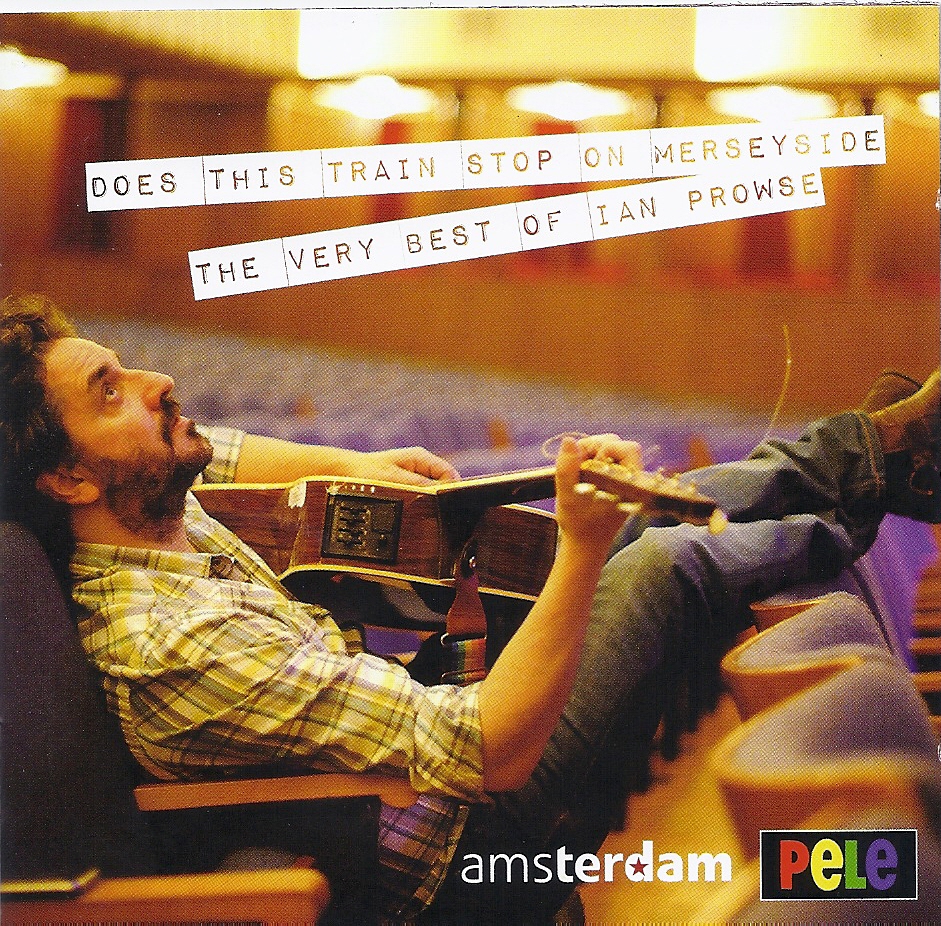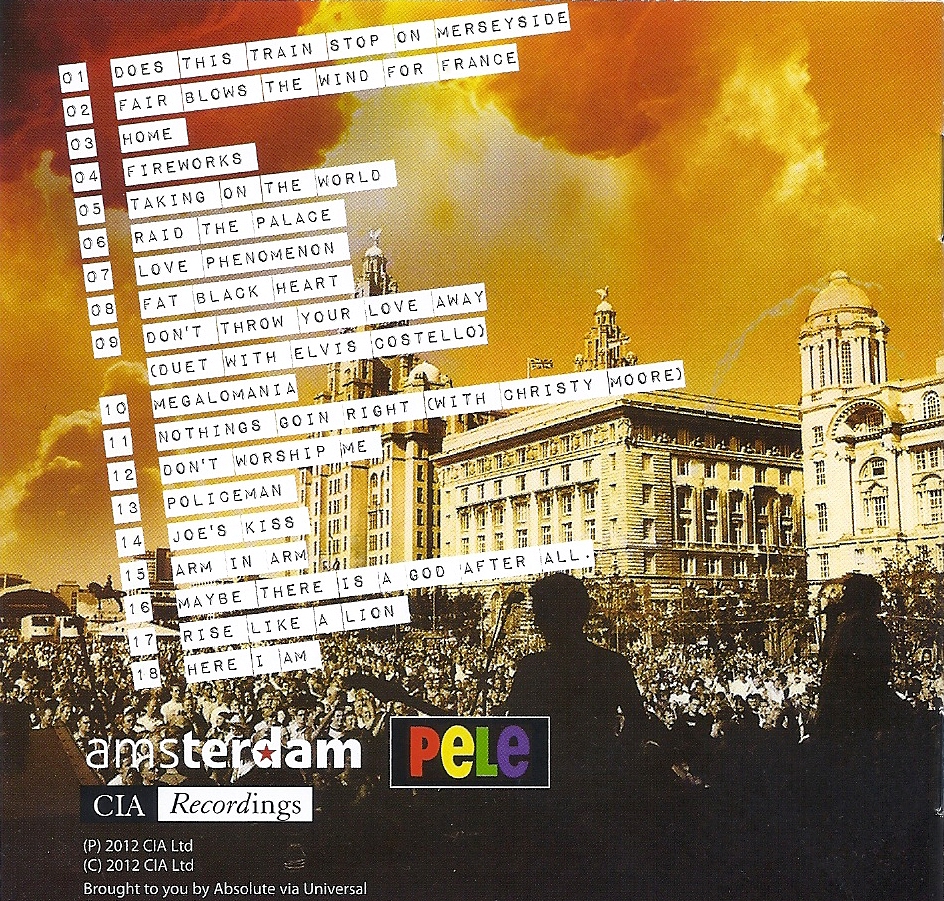Love Lane Lives
The history of sugar in Liverpool and the effects of the closure of the Tate & Lyle sugar refinery, Love Lane
Giants and the leaving of Liverpool
Written by Ron Noon at 16:05 on Sunday, April 22nd 2012
The eccentric but brilliantly creative artistic director of French company Royal De Luxe was responsible for transforming our port city, albeit for a weekend, into a land of giants! Sea Odyssey was a three day event which told the story of the little girl Giant searching for her father who had gone missing on the sunken Liverpool registered Titanic 100 years ago. Today as she and her 20 foot tall dog Xolo and 50 foot tall Uncle “stepped onto” a barge at Canning Dock to exit the city’s famous pier head, in front of tens of thousands of people, only a few sugarcentrics would have been introspecting about Tate & Lyle’s leaving and grieving of Liverpool on the same day 31 years earlier!
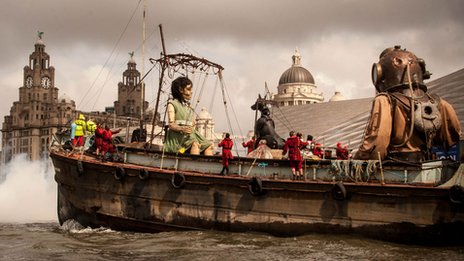
The above is a BBC picture which is used on this link: http://www.bbc.co.uk/news/uk-england-merseyside-17798401
Instead the massive influx of tourists and the indigenous scousers who had their spirits and imaginations raised by this spectacular event would only second the emotions of City Council leader Joe Anderson: “To have the world’s leading street theatre company bring the event to Liverpool is a real coup and another example of how internationally renowned artists want to showcase their work against the fantastic backdrop of our city.”
The backdrop to this blog is not those wonderful giants that evoked “tears of delight” as well as sadness as they exited the mouth of the Mighty Mersey on April 22nd 2012, but the ruthless transnational Sugar Giant that viewed what happened in Liverpool in the rundown to closure on April 22nd 1981 as nothing to do with sentiment or a sense of obligation to “Big ‘Enery’s” mother plant. Jean Luc Courcoult CELEBRATED a brilliantly successful weekend of street theatre to mark the centenary of the Titanic disaster, by jumping into the Mersey! A soulless transnational that has now completely divested from sugar as well as Liverpool is on this anniversary day still responsible, metaphorically at least, for throwing 1500 boys and girls from the whitestuff into the river of unemployment to sink or swim away to shore. Like Jean Luc Courcoult proved today people in this city have had to learn to swim. We are a city of the sea and once again on this historic day thank you Jean right down to your winkle picker shoes for reminding the world what this great city of ours still has to offer.
..................................................................................................................................................................................................................................................
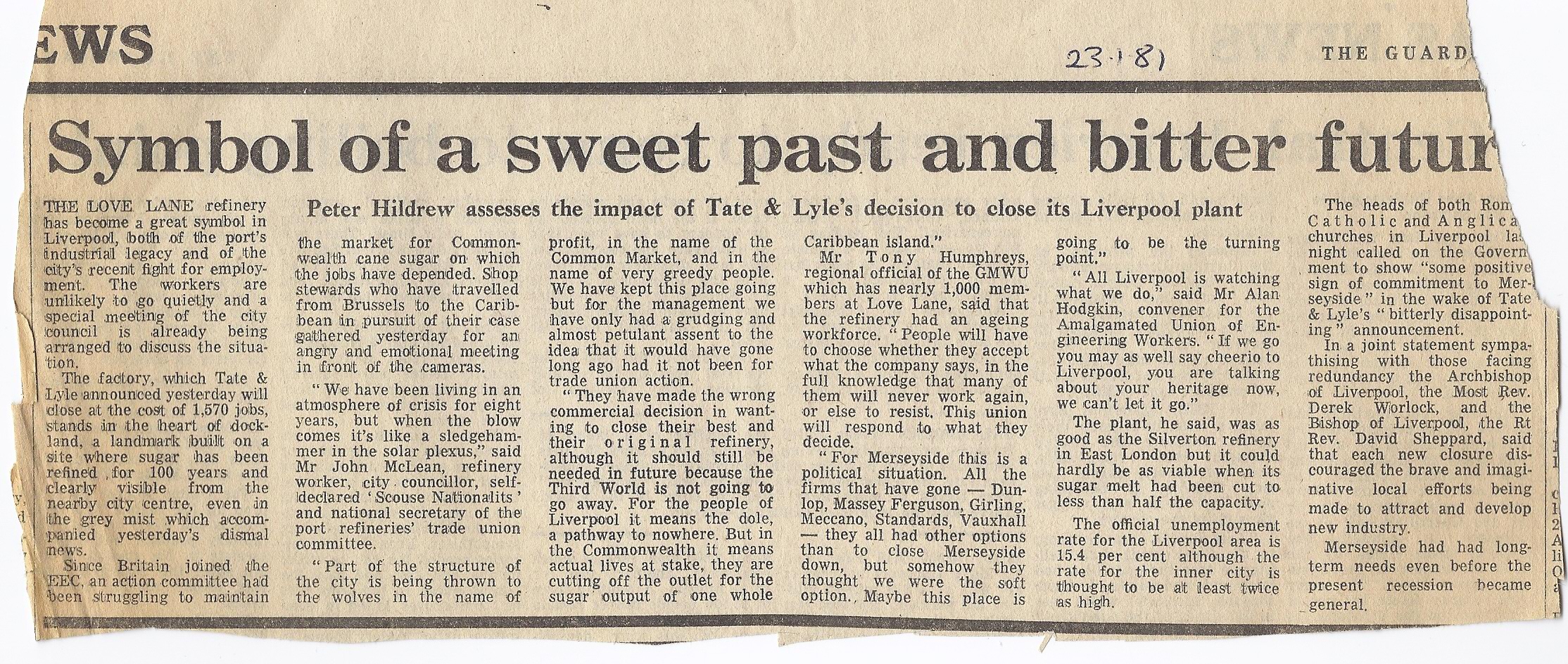
As well as that “on the spot” report by Peter Hildew of the Guardian on the 23rd April 1981, there is a good deal that I have already written about the closure of Love Lane in earlier blogs. The extract below is part of what I wrote for the North West Labour Historians Journal in October 2007:
The real story of sugar and Love Lane refinery is from a nutritional point of view, Sweet FA! It is an “empty calorie” shorn of any other nutrients, but achingly addictive and a perfectly legal drug for billions to be hooked on. We have no biological need for this refined chemical, technically termed sucrose, but despite the fact that it would be millennia before our innate “sweet tooth” and organoleptic senses became acquainted with “sugar”, our ancestors associated sweet with good and bitter with bad! In today’s “naughty but nice” era of processed profits, palatable junk food and globesity, the dissonance between tastiness and nutrition, renders those earlier instincts not only anachronistic but highly dangerous.
That said “there is no single food which has rivalled sugar in its influence on human affairs” and Fernando Ortiz a Cuban anthropologist, viewed it as “Capitalism’s favoured child”. This paper argues that the complementary chronologies of Capitalism and Sugar Cane Time, (sugar beet is a relatively new kid on the sugar block), and the particular case study of Liverpool’s bitter sweet past, provide excellent insights into Capitalism’s recurring themes of want, not need, wealth not health.
Tate Modern or Tate Sugar?
‘Sir Henry was a great philanthropist and entrepreneur, as generous as he was ambitious and forward thinking. Famed in his day for patenting sugar cubes, even he could not have foreseen the global success of Tate & Lyle, and the national and international importance of the Tate gallery’”.
Liverpool no longer imports and refines raw sugar but although no blue plaque commemorates sugar baron Henry Tate’s mother plant, or the city’s long association with this unique and much taken for granted commodity, there is however an absorbing Love Lane Refinery Lives film and oral history project. It has been backed by a Heritage Lottery Fund grant, and the studied ambiguity of the last word in the title is a permanent reminder of our major goal, to ensure that the story of the surviving “boys and girls from the whitestuff” lives on! An archive of film and oral biographies of the former Tate & Lyle workers will be supplemented by a website to facilitate a genuine bottom up version of Liverpool Labour and industrial history, and also to serve as an introduction to and permanent reminder of the politics and power of sugar! Now into its seventh century of global expansion it makes oil a relatively new kid on the politics block and the fact that they now drive “flex-fuel” cars in Brazil with ethanol derived from “energy cane”, portends even more non-food uses for this annually re-generable and far from historic crop.
It was supremely ironic that the closing scene in the last episode of Alan Bleasdale’s magisterially bleak Boys from the Blackstuff, (‘George’s last ride’), shown on BBC, November 7th 1982, was filmed on the day when Love Lane refinery was being bulldozed to the ground. The award winning series with an ensemble cast put together by the Scouse Dickens, highlighted the sheer waste, futility and demoralisation of being without work in Thatcher’s Britain, especially in a city described as the Bermuda Triangle of British Capitalism. “In the 20 years after the height of Liverpool’s post-war ‘golden age’ in 1965, the city and the Merseyside region in general were ravaged by fallout from severe global economic recession. Between 1966 and 1977 no less than 350 factories in Liverpool closed or moved elsewhere, 40,000 jobs were lost and between 1971 and 1985 employment in the city fell by 33 per cent.”
Bleasdale may have been subliminally aware of the proxy voices of the 1,570 boys and girls from the whitestuff who had gone down the road on April 22nd 1981, but the physical destruction of the refinery and use as background to yet another manic pub redundancy party in the Green Man, seared itself into the nation’s consciousness more effectively than the national unemployment demonstrations of the time. How many viewers would have realised that the destruction of the charmingly named site was the physical end of over 300 years of sugar refining in Liverpool? A multinational before the term was shoehorned into the lexicon, “Tates” was nonetheless perceived as “local” and paternalistic, and with no evidence of serious industrial relations hiccups since 1926, the closure reminded those who viewed it as “a city within a city” how “all that’s solid eventually melts into air”?
In the eighteenth century ships sailing in and out of the Mersey contained the classic products of an infamous triangular trade but how many Liverpool ladies perambulating along the romantically named “Love Lane, Ladies’ Walk and Maidens’ Green”, overlooking captivating views of river traffic and Welsh mountains, asked about the conditions under which those goods were produced? Sixty five years after the abolition of the slave trade a former grocer, born in Chorley, Lancashire, lay the foundations for an imperial sugar dynasty, by building a refinery in a Love Lane, far removed from rural arcadia, and intersected by the Leeds Liverpool canal and adjacent warehouses. When 109 years later the then tragically misnamed refinery, closed down, it served as a potent reminder of Liverpool’s twentieth century economic malaise and rundown from Gateway to Empire status, as well as an amazingly dramatic stage prop for Bleasdale’s zeitgiest character, Yosser (‘gis a job’) Hughes.
According to J.A.Watson, “its end was a bitter blow not only for those who worked or had worked there, but to the whole of Liverpool where the name of Tate & Lyle was held in the highest esteem. Tate & Lyle was Liverpool. ‘It’s dead now’ was a typical opinion, expressed in this instance by a woman casually met in the course of gathering material for this book. She meant Liverpool was dead, not Tate & Lyle”. Fortunately, judging by next year’s European Capital of Culture award, her reading of the tea leaves proved premature but dead right about the sugar, given that the FTSE 100 Sugar Giant, shorn of its original ethnicity, has never looked back on that act of matricide and the grieving of Liverpool. Indeed when the critical decision was taken to close Love Lane, the board of directors contained neither a Tate nor a Lyle and was headed by Lord Jellicoe, the first chairman from outside the families.
Unlike Watson’s professedly “neutral opinion” that “closure could not have been prevented by the company acting on its own” another company historian Phillipe Chalmin admits that the closure and disappearance of a prominent Liverpool landmark, owed to “the ‘treachery’ committed by a firm which had been born there little over a century earlier”. As a socialist and Labour historian what drew me to this project were the refinery workers not the product and certainly not Tate & Lyle. That said Albert E Sloane and John Mclean, my two sweet fightin’ mentors on the ten year struggle to keep the plant open, sagely advised “if you get to understand sugar you will understand capitalism”. The only thing that mattered to me about sugar before this project, was that it was sweet, but I soon discovered “what a bitter taste sugar takes on” when that global and local history is reconstructed.
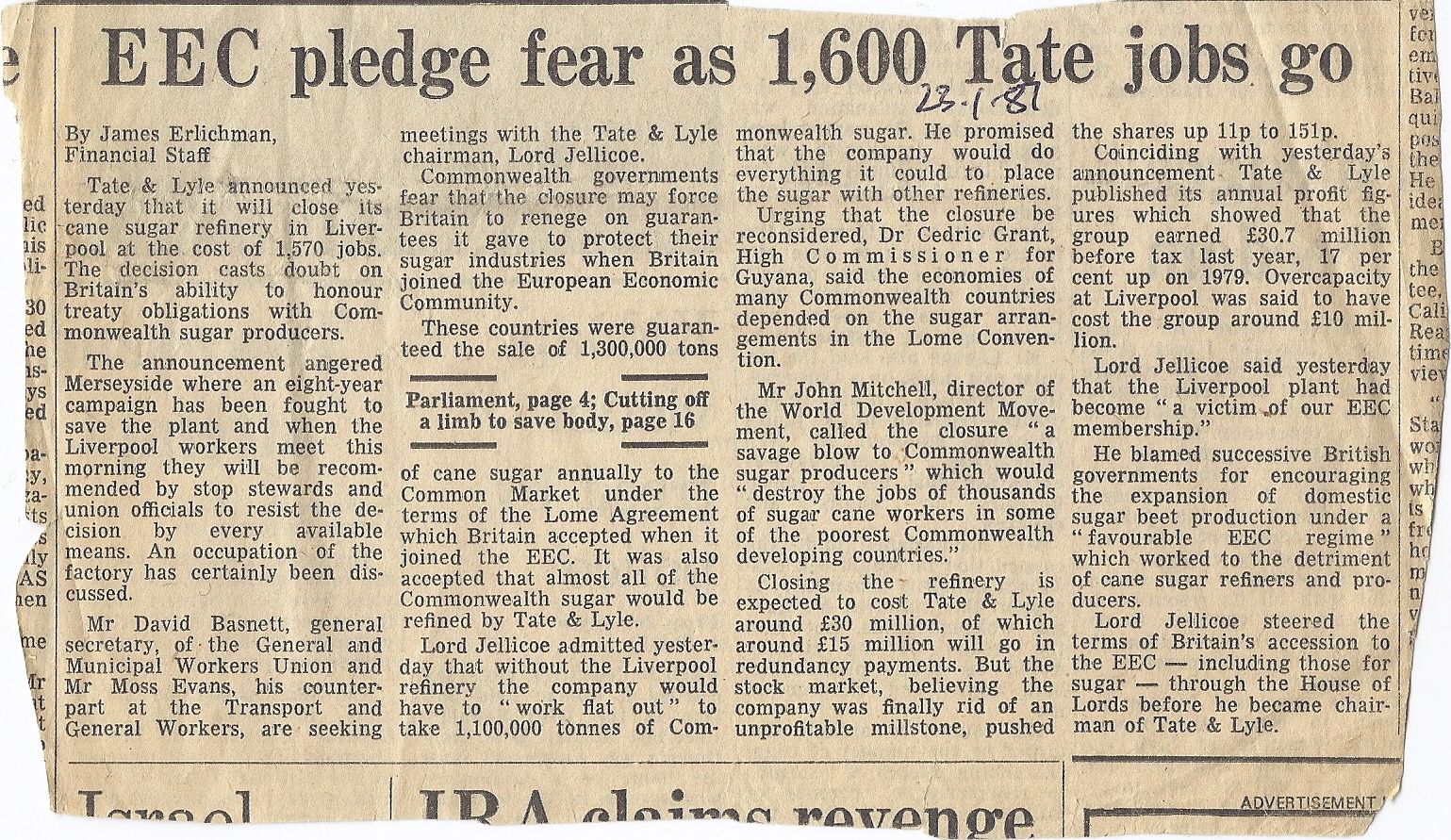
P.S. Check this link out on our site. This is how we bring in musical talent to encourage children to imaginatively reconstruct how “their community” was impacted on in 1981 by the closure of Love Lane.You can now listen to Ian Prowse’s efforts with the children of Hillside school who devised a SAVE OUR SUGAR protest song, albeit now 31 years out of date. Or is it?
http://www.lovelanelives.com/index.php/blog/entry/save_our_sugar/
What’s my former History student doing now? Well I was there last night when he played a gig in Liverpool to celebrate this:
